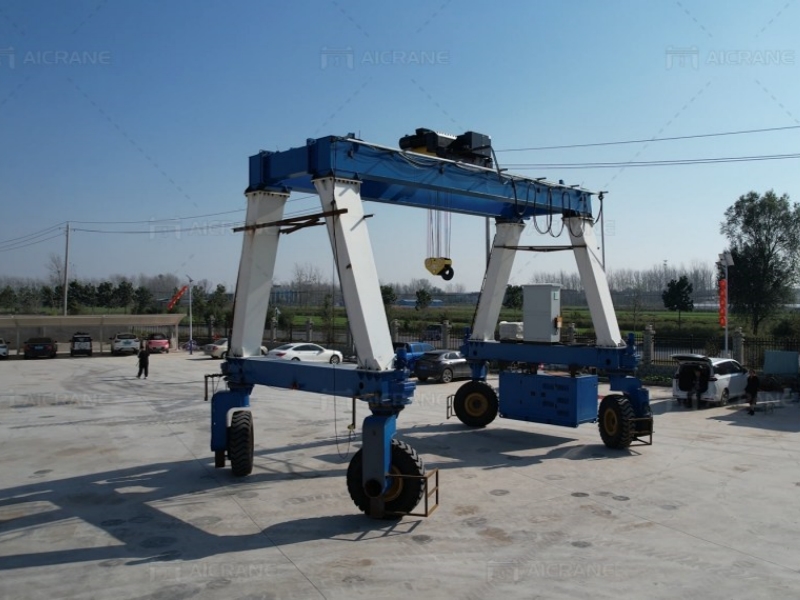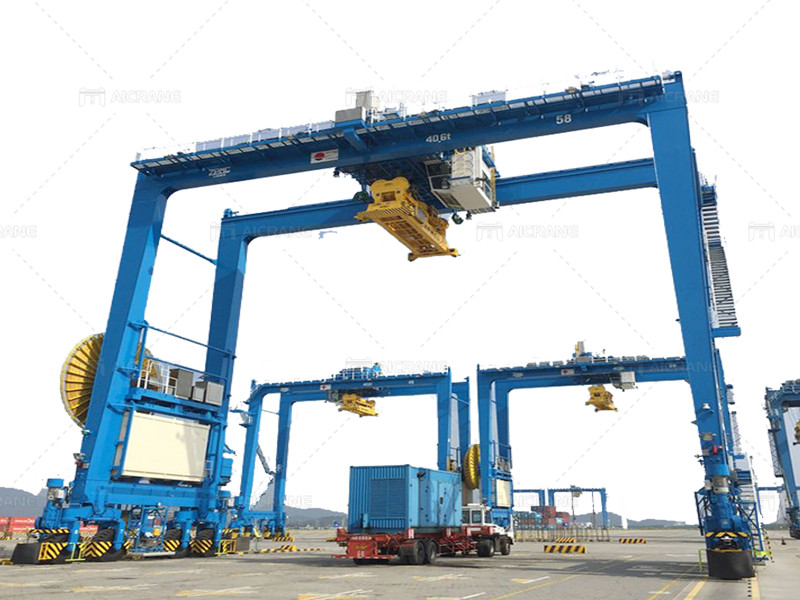Changing tires on a rubber gantry crane is a meticulous procedure that requires careful planning, the proper tools, and a stringent adherence to safety protocols. Rubber gantry cranes, also known as rubber-tired gantry cranes (RTGs), are essential in various industries, particularly in shipping yards and container terminals. These cranes are mobile and versatile, which makes them invaluable for handling and transporting heavy containers. However, their mobility is heavily dependent on their tires, and ensuring these tires are in optimal condition is crucial for the safe and efficient operation of the crane. Here’s a comprehensive guide on how to change tires on a rubber gantry crane.

Preparation and Safety Measures
Before initiating the tire-changing process, it is vital to prioritize safety. The process starts with securing the area where the tire change will take place. Ensure that the crane is on stable, level ground to prevent any movement during the procedure. Barricade the area and put up warning signs to keep unauthorized personnel away. Additionally, wearing personal protective equipment (PPE) such as hard hats, safety gloves, steel-toed boots, and high-visibility vests is mandatory for all personnel involved in the tire-changing process.
Tools and Equipment
Having the right tools and equipment is crucial for a smooth tire change. The essential tools include heavy-duty jacks, jack stands, a torque wrench, tire irons, a pneumatic or hydraulic impact wrench, and a heavy duty gantry crane https://aicranemachine.com/gantry-crane/heavy-duty/ for lifting heavy tires if necessary. Ensure that all the tools are in good working condition before beginning the process.
Step-by-Step Procedure
Step 1: Stabilize and Secure the Crane
First, power down the rubber gantry crane and engage the parking brakes to ensure it does not move. Use wheel chocks to block the wheels that are not being changed to prevent any accidental movement. If the crane is equipped with stabilizers, deploy them to provide additional support.
Step 2: Lifting the Crane
Position heavy-duty jacks under the crane at the designated lifting points. Rubber gantry cranes are equipped with specific lifting points to ensure safe and balanced lifting. Carefully raise the crane using the jacks until the tire that needs to be changed is slightly off the ground. Once lifted, place jack stands under the crane to provide additional support and stability.
Step 3: Removing the Old Tire
With the crane securely lifted and stabilized, use the pneumatic or hydraulic impact wrench to loosen and remove the lug nuts from the old tire. Carefully remove the tire from the axle. Due to the size and weight of the tires on a rubber gantry crane, it may be necessary to use a secondary crane or lifting device to safely handle the tire.

Step 4: Inspecting the Components
Before installing the new tire, take the opportunity to inspect the wheel hub, axle, and brake components for any signs of wear or damage. Clean the hub to remove any debris or corrosion that could affect the performance of the new tire. This is also a good time to check the condition of the other tires and perform any necessary maintenance.
Step 5: Installing the New Tire
Position the new tire onto the axle, ensuring that it is properly aligned with the wheel hub. Hand-tighten the lug nuts to hold the tire in place. Once the tire is secure, use the impact wrench to tighten the lug nuts in a star pattern. This ensures even distribution of pressure and prevents the wheel from becoming misaligned. Refer to the manufacturer’s specifications (like Aicrane) for the proper torque setting and use a torque wrench to achieve the correct tightness.
Step 6: Lowering the Crane
With the new tire securely installed, gradually lower the crane using the jacks. Remove the jack stands and continue to lower the crane until all its weight is back on the tires. Remove the wheel chocks and retract any stabilizers that were deployed.
Post-Installation Checks
After the crane has been lowered and the area cleared, conduct a thorough inspection to ensure that everything is in order. Check that all lug nuts are properly tightened and that the new tire is seated correctly. It’s also important to perform a test run of the crane to ensure that it operates smoothly and that there are no unusual noises or vibrations.
Documentation and Maintenance Records
Maintaining accurate records of all maintenance activities, including tire changes, is essential for the ongoing reliability and safety of the rubber gantry crane. Document the date of the tire change, the condition of the old tire, the specifications of the new tire, and any other maintenance performed during the process. This information is invaluable for tracking the performance of the crane and planning future maintenance activities.
Changing tires on a rubber gantry crane is a critical maintenance task that requires attention to detail, the right tools, and strict adherence to safety protocols. By following the outlined steps, you can ensure that the process is carried out efficiently and safely, minimizing downtime and maintaining the operational integrity of the crane. Regular maintenance and timely tire changes are essential for the longevity and reliability of rubber gantry cranes, allowing them to continue performing their vital roles in various industrial applications.